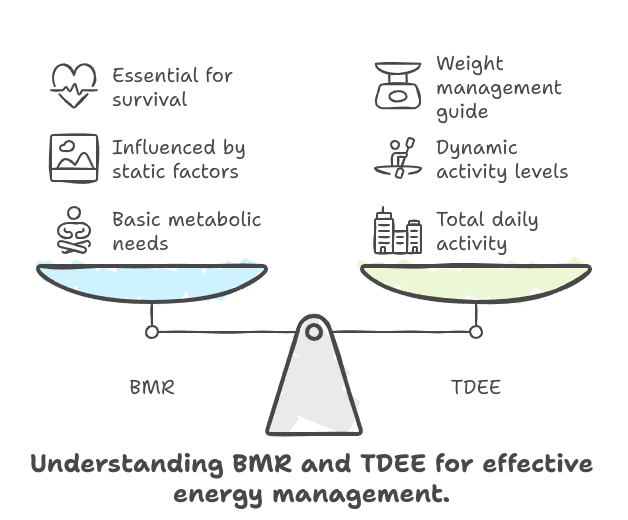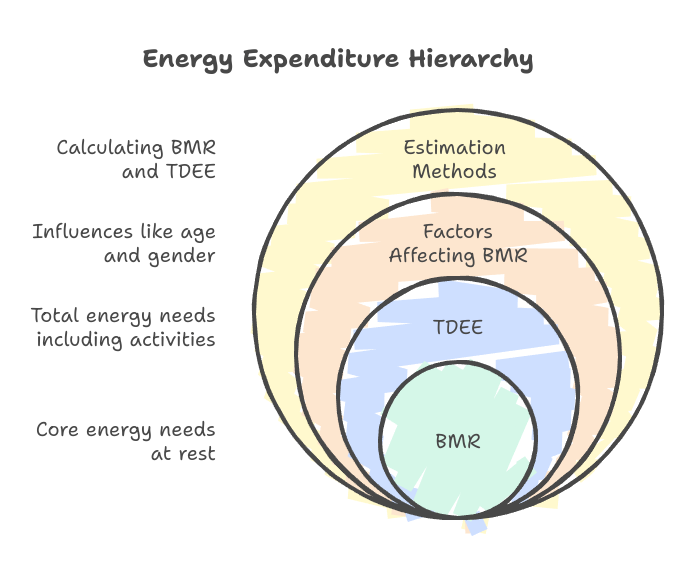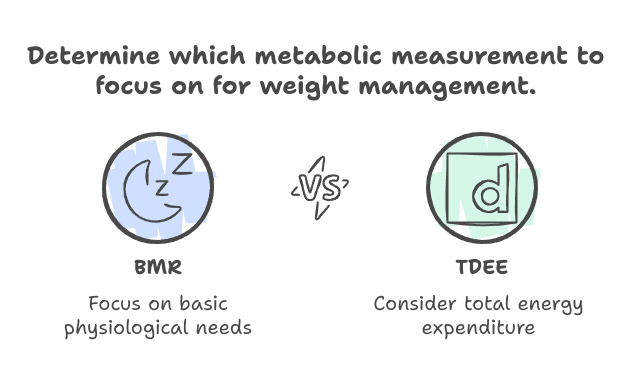BMR vs TDEE Explained: Unlock the Secrets to Effective Weight Loss 🔓
Are you trying to lose weight but feeling confused by all the numbers and acronyms? Don’t worry, we’ve got you covered! Let’s dive into the difference between BMR and TDEE and how understanding these concepts can help you reach your weight loss goals. 💪
Key Takeaways:
- BMR is the number of calories your body needs at rest to maintain basic functions
- TDEE is the total number of calories you burn in a day, including activity and digestion
- Calculating your BMR and TDEE can help you create a realistic calorie deficit for weight loss
What are BMR and TDEE and How Do They Differ?

BMR stands for Basal Metabolic Rate, while TDEE is short for Total Daily Energy Expenditure. While they both involve calories, they represent different aspects of your body’s energy needs.
What is Basal Metabolic Rate (BMR)?
Your BMR is the minimum number of calories your body needs to function at rest. It accounts for the energy required for essential processes like breathing, circulation, hormone regulation, and cell production. Factors such as age, gender, weight, height, and body composition all influence your BMR.
Calculating BMR: The Mifflin-St Jeor Equation
To calculate your BMR, you can use the Mifflin-St Jeor equation:
Women: BMR = 10 x weight (kg) + 6.25 x height (cm) − 5 x age (years) − 161 Men: BMR = 10 x weight (kg) + 6.25 x height (cm) − 5 x age (years) + 5
For example, a 35-year-old woman who weighs 70 kg (154 lbs) and is 165 cm (5’5″) tall would have a BMR of 1,383 calories.
There are many BMR calculators available online, some of which may require additional information like body fat percentage for more accurate results.
What is Total Daily Energy Expenditure (TDEE)?

Your TDEE represents the total number of calories you burn in a day, including your BMR, physical activity, and the thermic effect of food (TEF). It’s the sum of four main components:
- BMR
- TEF (calories burned during digestion)
- TEA (calories burned during exercise)
- NEAT (calories burned through non-exercise activities like fidgeting or housework)
Calculating TDEE using BMR and Activity Factor
To estimate your TDEE, multiply your BMR by an activity factor based on your lifestyle:
- Sedentary (little to no exercise): BMR x 1.2
- Lightly active (light exercise 1-3 days/week): BMR x 1.375
- Moderately active (moderate exercise 3-5 days/week): BMR x 1.55
- Very active (hard exercise 6-7 days/week): BMR x 1.725
- Extra active (very hard exercise, physical job): BMR x 1.9
Using the previous example, if the woman is moderately active, her TDEE would be 1,383 x 1.55 = 2,144 calories per day.
How to Use BMR and TDEE for Weight Management

Now that you know your BMR and TDEE, how can you use these numbers to support your weight loss journey? The key is creating a calorie deficit by consuming fewer calories than your TDEE.
Setting Realistic Calorie Goals for Weight Loss
A safe and sustainable rate of weight loss is 1-2 pounds per week. To achieve this, aim to subtract 500-1,000 calories from your TDEE. However, avoid eating less than your BMR, as this can trigger “starvation mode” and slow down your metabolism.
Macronutrient Allocation for Weight Loss
In addition to calorie intake, pay attention to your macronutrient balance (protein, carbs, and fat). A good starting point is:
- Protein: 1 gram per pound of body weight
- Fat: 0.3-0.5 grams per pound of body weight
- Carbohydrates: remaining calories after protein and fat
Meal Planning Tips for Reaching TDEE Goals
- Focus on whole, minimally processed foods
- Incorporate plenty of fruits, vegetables, lean proteins, and healthy fats
- Practice portion control using measuring tools or visual cues
- Plan and prep meals in advance to stay on track
Common Misconceptions about BMR and TDEE
BMR vs. RMR (Resting Metabolic Rate)
While often used interchangeably, BMR and RMR are slightly different. RMR includes the calories burned during digestion and minor movements, making it marginally higher than BMR.
Starvation Mode and Calorie Restriction
Severely restricting calories (eating below BMR) can backfire by causing your body to conserve energy and burn fewer calories. Aim for a moderate deficit to avoid this metabolic adaptation.
Health Considerations and Individual Variations
Keep in mind that BMR and TDEE calculations are estimates and may not account for factors like:
- Underlying health conditions (e.g., hypothyroidism)
- Muscle-to-fat ratio
- Hormone levels
Always consult with a healthcare professional before starting a new diet or exercise regimen, especially if you have any pre-existing medical conditions.
BMR and TDEE for Effective Health Management
Understanding the difference between BMR and TDEE is a crucial step in your weight loss journey. By calculating these values and creating a realistic calorie deficit, you can work towards your goals in a healthy, sustainable way. Remember to focus on nourishing your body with whole foods, staying active, and being patient with the process. 🌟



